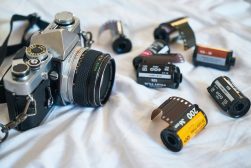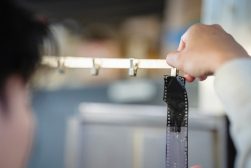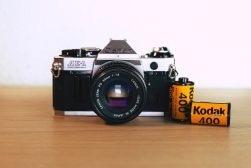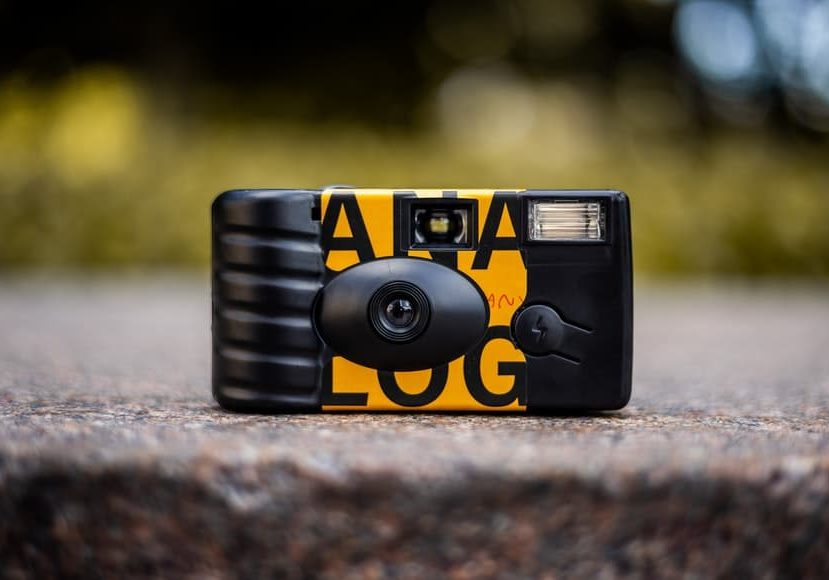
Guide to Disposable Cameras: Developing & How They Work
From how they work to developing your film at home, here's what to know about disposable cameras. Includes expert tips for getting better shots!
Film Photography | Learn | By Ana Mireles
Despite the prevalence of digital cameras and smartphone photography, disposable cameras are still hugely popular here in 2024.
Most disposable film cameras feature a flash and a fixed focal length, producing a unique nostalgic image style, popular with a subculture of dedicated users.
Since they’re inexpensive, easy to operate, and hard to break, they’re also popular at events and weddings.
Whereas instant cameras require expensive film, disposable film cameras can only be used once, and that’s part of their appeal.
In this age of instant gratification, having to wait for the film from a disposable camera to be developed is another quality that helps explain its consistent popularity.
In this guide, you’ll discover everything you need to know about the disposable film camera and why you might need one in 2024.
What is a disposable camera?
Essentially, disposable cameras are a type of film camera designed to be single use.
When all the shots are used up, the whole camera is then sent back to be developed.
These cameras come in many varieties including some designed for underwater photography.
How Do Disposable Cameras Work?
“How does a disposable camera work?” you may ask. It is relatively simple, really. A disposable camera – also called a single-use camera – is a plastic camera with the film already loaded. You simply use the viewfinder to compose your photo.
Keep in mind that just like any point-and-shoot, you’ll have to compensate for the parallax effect.
Most disposable cameras have a fixed aperture and a fixed shutter speed. At most, you can choose the ISO of the film when and where you buy the disposable camera (you can’t change it later because it comes with the film inside).
This simplicity makes learning how to use disposable cameras quite easy.
If the disposable camera has a flash feature, you can switch it on and off as needed. Usually, you can leave it on unless there’s something reflective in front of you. (Further on in the article, you’ll find a few disposable camera tips to improve your photos.)
Then, press the shutter to take the photo. Lastly, turn the advance wheel to activate the winding gear until it stops – that means you’re on the next frame. You can see how many exposures you have left on the top of the camera.
Once you’ve taken all the photos available, you can take the camera to the film developers. You can ask them for printed photos or digital versions.
Many brands have single-use cameras. The Fujifilm disposable camera is called Quicksnap, and the Kodak disposable camera is called FunSaver. Also, Agfa, Lomo, and Ilford have disposable cameras – they had a resurgence in popularity in 1993 in Japan.
It’s not just the brand that changes: you can choose the number of exposures, a model with or without flash, or opt for a waterproof disposable camera.
You can even get a digital disposable camera with internal storage instead of a memory card, and you need to take it to the lab for those pictures to be downloaded.
As you can imagine, these devices aren’t very popular as you can get a point-and-shoot digital camera to use as much as you want for a little extra cost.
How Much Do You REALLY Know About Photography?! 🤔
Test your photography knowledge with this quick quiz!
See how much you really know about photography...

Now you’ve understood how disposable cameras work, let’s take a look at how disposable camera photos look.
What do disposable camera pictures look like?
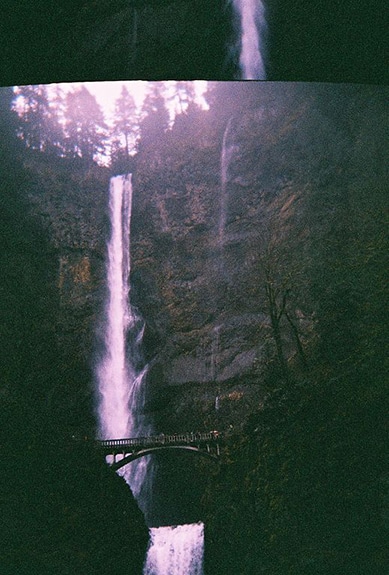
Credit: ASubjectHasBeenRemovedFromAllDocuments, CC BY-SA 4.0 via Wikimedia Commons
When you use a disposable camera, you can’t expect to have the sharpness that you’re used to having with a digital camera.
Since a single-use film camera has plastic optics and a fixed focus lens, you’ll get softer images that might look slightly blurred.
The quality of the photo also depends on the exposure conditions – usually, these cameras don’t perform very well in low light, and the flash gives a bright light that tends to flatten the subject.
The ISO that you choose will also give a different result. Getting a camera with an 800 ISO will be grainier than one with a 400 ISO.
Also, keep in mind that when you capture images with a disposable camera, you won’t be able to adjust the white balance. So, you’ll probably have a color cast – for example, yellow when tungsten bulbs give the ambient light.
As a result of all of this, you’ll get a vintage-looking picture with soft focus, low contrast, some grain, and probably a color cast. You might even get a light leak if the camera is not well constructed or if you reloaded it.
Although the explanation sounds like you won’t have a good picture, keep in mind that we continuously try to recreate this look by applying filters to photos taken with a digital camera. So, why not try the real thing?
If you’ve never shot a disposable Kodak camera yourself, give it a go! (Disposable Fujifilm cameras are also available too.)
Related: Kodak history.
How do disposable cameras get developed?
How to develop disposable cameras is relatively straightforward. Take the entire camera into a lab or a store to get your film developed. Depending on where you live, you might find multiple options like pharmacies and supermarkets.
If you live in the US, you can go to Walgreens, Walmart, or CVS – see our guide on whether you should develop disposable cameras at Walmart.
If these services are not as accessible in your area, try calling some professional photography labs and ask if they can do it.
There are mail-in disposable camera developing services for when taking your disposable camera in person proves to be difficult or impossible. The Dark Room is one of the most famous, and you can get your photos from your disposable cameras printed or scanned. They also recycle the camera for a more eco-friendly process.
Other websites are Richard Photo Lab, Process One, and Shutter Junkies.
If you have the prints from your disposable camera and want to get them in a digital form to share online or simply to store as a digital backup, you can do it yourself.
You can use the camera from your phone as a scanner – there are multiple apps available. You can also use an actual scanner. This works well to scan the prints or the disposable camera film.
For professional scanning services, in case you require a higher resolution or have any special needs, you can go to any photo lab or search for “where to develop film near me” on Google for local results.
Can you develop a disposable camera yourself?
Disposable cameras are supposed to be single-use cameras. So, you can develop the film roll from a disposable camera by yourself, but in most cases, this means that you have to break the disposable camera that’s holding it.
This isn’t the case for all camera brands and models; there are some, like the Kodak Fun Saver, that can be opened without breaking. This is only relevant if you want to reload a disposable camera – if you only want to develop the film, then it doesn’t matter if you break it.
Unlike a reusable camera, disposable cameras start with all the film rolled out of the canister, and you start shooting from the last frame – this is because they don’t have a rewind system. As a result, you can open the camera in broad daylight.
Then, you can develop the film exactly as if it was shot with any other film camera. Start by opening the canister, taking out the film, and loading it into the film tank. You need to be in complete darkness or use a dark bag for this part.
Now, it’s time to start the developing process according to the type of film. Most cameras have a color film, so you’ll need to use a C-41 process.
You should follow the instructions of the specific kit that you buy, but it roughly goes something like this:
- Prepare the chemicals.
- Fill the tank with the C-41 color developer warmed at 38 degrees Celsius for 3 min 15 sec.
- Then add the BleachFix, warm at 38 degrees Celsius, and leave for 4 minutes.
- After the time is up, rinse the film.
- Add the stabilizer at room temperature for 1 minute.
You can choose between different developing chemicals if you have a black-and-white disposable film camera. You can find the developer as powder or liquid – prepare it by following the instructions of the one you got. Then get the stop bath, the fixer, and the PhotoFlo.
You can check our guide to how to develop film for more detailed information, but this is roughly how it goes:
- Soak the film with lukewarm water for 3-4 minutes.
- Use the developer as instructed on the package.
- Pour the stop bath for 2 minutes.
- Pour the fixer.
- Rinse the film.
- Add PhotoFlo.
Here’s how to get disposable camera pictures on your phone.
How to Use a Disposable Camera: 3 Tips
- Pay attention to the ISO – In the same way that you can choose the ISO if you buy the film for reusable cameras, you can select the sensitivity of a disposable camera. Most cameras are loaded with a 400 ISO film, but if you know you’re going to use the camera in low light situations, get one with 800 ISO.
- Learn when to avoid using flash – Not all disposable cameras have a flash. If yours has one, it’s usually OK to use it. However, avoid using it when something in front of you has a reflective surface. A mirror or a metallic surface will make the flash bounce back at the camera, causing flare or overexposing your photo completely.
- Stay close to your subject if you’re using flash – Disposable cameras don’t have a very powerful flash. So, stand closer than 10 feet from your subject when shooting your photos. Using the flash isn’t useful for photographing landscapes or buildings.
Do Disposable Cameras expire?
A disposable camera essentially lasts as long as the film in it. This is because the camera in itself doesn’t have an expiration date, but you can’t load a new roll into it.
Usually, a film lasts three to four years after being manufactured. The duration greatly depends on how it was stored.
Keeping your film in the fridge is a good way to extend its life without requiring any professional measures. However, you shouldn’t use your disposable camera immediately after you take it out.
Instead, take it out of the fridge the night before the photo shoot. This way, it will slowly adapt to room temperature.
The Harrison Cameras’ website suggests that you use the freezer instead of the fridge if you’re not going to use a film for more than six months. This advice should apply to disposable cameras as well.
You can use it and develop it after the expiration date, but there’s no warranty on how the pictures will come out.
If you like experimental photography, you shouldn’t worry about using expired disposable cameras.
However, stick to the expiration date if you are looking for accurate colors and consistent results.
Disposable Camera FAQS
How many pictures do you get in a disposable camera?
If you’re familiar with film photography, you might know that film rolls can typically have 12, 24, or 36 exposures. Well, in the case of disposable cameras, the standard number is 27 – although you can find some of them with 36 or 39.
Can disposable cameras be reused?
As the name says, disposable cameras are meant to be used once and discarded. However, some of them are somewhat easy to disassemble and load with a new film.
How do you fill a disposable camera?
Most disposable cameras aren’t meant to be reloaded. However, if you manage to open one without breaking it, you can put in a new film. You have to do it in a dark room or use a dark bag because the trick is to attach the tip of the film to the spool and roll it all out. Then, fix the film canister in place and put the disposable camera back together. Use some black sealing tape to avoid any light leaks and take the first photo. Turn the advance wheel and see if it stops at the next frame – this means it’s loaded correctly. If you notice that it continues to turn indefinitely, put it back in the dark bag and open it again to fix it.
How much does it cost to develop a disposable camera?
The cost depends on where you live and whether you get prints, if you have to pay for delivery services, etc. However, on average, you could spend something between US$15 and US$30.
Do disposable cameras need batteries?
Disposable cameras work mechanically, so they don’t need batteries unless they have a flash. The flash of the camera does need batteries to operate.
How do I know when my disposable camera is empty?
Disposable cameras, like digital cameras or any other film cameras, have a display counter that lets you know how many exposures are left. In most cases, you find it at the top of the camera on the right – close to the advancing wheel and the shutter.
What can I buy instead of a disposable camera?
If you want images with a similar look to a disposable camera without using a single-use camera, you can check the Lomo Simple Use, the Snap LF-35M, or the Ilford Sprite 35II.
Can disposable cameras go through security?
The X-rays from a security checkpoint can damage the disposable camera’s film. If you’re traveling with your camera, it’s better to bring it in your carry-on bag because the X-rays are less damaging to film than the ones used on checked luggage.
Do metal detectors ruin disposable cameras?
Disposable cameras shouldn’t be affected by metal detectors because they don’t use X-rays – they use a pulsing magnetic field.
Should you always use flash on a disposable camera?
You don’t necessarily need to use flash for disposable camera photos. Many of them don’t even have a flash. Even if you do have a flash, you shouldn’t use it when there’s a reflective surface that could bounce the flash back at the camera and potentially ruin your photo. Also, if you’re photographing a landscape or something that’s further away, the flash won’t be powerful enough to light it. To work without flash, just make sure there’s enough light available (e.g., shoot during the day).
How to use a Fuji disposable camera?
To use a Fuji disposable camera, all you have to do is dial the wheel on the back of the camera all the way until it locks. After that, you can start taking pictures by pressing the big button on top.
If you need the flash, switch the button on the front of the camera to “on.”
How to develop a Fujifilm disposable camera is quite straightforward too. Just simply send the camera to the developing lag and wait for the pictures to arrive.
What size are disposable camera photos?
The size of most disposable camera photos is 4×6 inches.
Can you refill disposable cameras?
Yes, you can refill disposable cameras. However, you’ll have to dismantle the camera in order to install a new film and battery.
Does airport security ruin disposable cameras?
Yes, airport security can ruin disposable cameras because the X-ray scanners affect the film inside of them.
What kind of film is in a disposable camera?
Most disposable cameras have 35mm film.
Conclusion: Are disposable cameras worth it?
I hope that now you know how disposable cameras work, you’ll agree that they are a great alternative to digital cameras in many situations.
One of the most popular uses is to put different disposable cameras on the guest tables at weddings or big events. That way, the guests can leave you full of personal memories and candid shots to complement the job of the official photographer.
Disposable cameras are also an excellent way to introduce yourself to film photography without spending too much money. This will help you learn and practice how to develop film at home and get your creative juices going by capturing images with a nostalgic, vintage feel.
Single-use cameras might also be a great solution for your next vacation. Bring a disposable camera with you to a place where you feel that your expensive camera could get damaged or robbed. Also, you can give one to each family member – especially kids if you want to get them off the screen and have a different experience.
As for underwater photography – if you want to shoot underwater but don’t want to make a significant investment for a one-time thing, waterproof disposable cameras are a great idea.
In conclusion: even though we have a smartphone camera with us at all times, I think disposable cameras still have a place in our lives. Do you agree? Share your thoughts in the comments!

Check out these 8 essential tools to help you succeed as a professional photographer.
Includes limited-time discounts.







